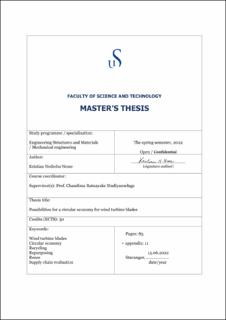| dc.description.abstract | The wind industry has been growing steadily over the past decade due to an increasing focus on developing renewable energy. A wind turbine has a designed lifetime of 20 to 30 years where almost 90% of the turbine can be recycled at end-of-life (EoL). The challenge is the blades, which are made of composites, usually glass fibre-reinforced plastics (GFRP) or carbon fibre-reinforced plastics (CFRP). The common practice for many years has been to landfill the decommissioned blades, gaining no benefit from the material. Due to the steady development of new wind farms, the waste problem is expected to increase and there is therefore a necessity for new solutions.
The European Union (EU) plans to become climate neutral by 2050, where a transition to a circular economy is one of the prerequisites for the EU to reach its goals. Circular economy is an economic system of closed loops, meaning that raw materials, components, and products lose their value as little as possible. In a circular economy, waste is considered a design flaw, and the possible waste should be treated as a resource.
In this thesis, the wind turbine blade supply chain and the current possibilities for handling wind turbine blade waste was investigated. Then the possibility for a circular economy for wind turbine blades were investigated. By using circular economy strategies from the building sector and the Ellen MacArthur Foundation’s definition of circular economy, action that can lead towards a circular economy for wind turbine blades were proposed. A circular economy framework for wind turbine blades was also made.
The different EoL-options for wind turbine blades (reuse, repurposing and recycling) were investigated. The market for direct reuse of wind turbine components has been active for over a decade and is the best option as it keeps the blade for its original purpose. Reusing the blades will further contribute to production of clean energy. Repurposed blades have been demonstrated for use in bridges, playground, and urban furniture. The lifetime of the repurposed applications can be up to 60 years and the best environmental benefit is achieved where it substitutes steel and concrete. For recycling, three methods have reached a Technological Readiness Level (TRL) of 9: mechanical recycling, co-processing, and pyrolysis. The recycled material has not been reintroduced into new wind turbine blades by any of these methods. The most promising alternative to these methods is solvolysis, which enables the recovery of long fibres and has possibilities for using the recovered material in new wind turbine blades. In addition, the design phase for turbine blades was investigated. One of the major developments is the change from thermoset to thermoplastic resin systems, which enables easier recycling through solvolysis. The next step towards a circular economy for wind turbine blades will be to use recycled fibres in the design of new blades. | |
